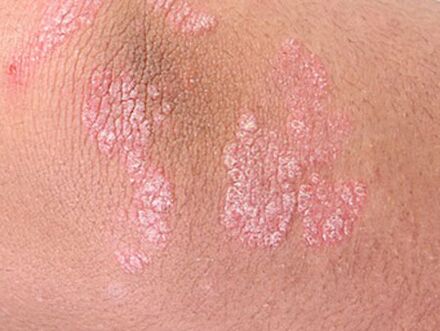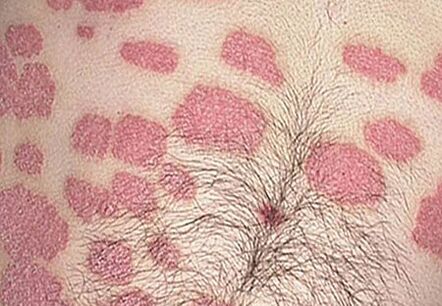What is it? Psoriasis is a non -infectious skin disease, so it is impossible to be infected. It affects not only the skin, but also has a negative effect on the entire body as a whole. It is characterized by a chronic course with periods of exacerbations and remissions.
The disease is caused by the immune cells of one's body, that is, it is an autoimmune disease. Go up from the depths of the skin to the upper layers, these cells cause inflammation, the excessive division of epidermis cells, leading to excessive growth, the appearance of new small capillaries.
Externally, it seems the formation of red or red points - psorial plates.
The first signs and symptoms of psoriasis

Since psoriasis - a systemic disease that affects all body systems - the patient suffers from general weakness, rapid fatigue.
The main symptom of the initial phase of psoriasis are rashes and psorial plates, however, accompanies a person with the further development of the disease.
They are presented due to the acceleration of the unsuccessful division of the cells located in the upper layer of the skin-firetaryocytes. The cells involved are formed and the skin in these areas thickens, acquires red due to the best formation of new capillaries. This leads to minor drop bleeding for any lesion, even light, lesions to plates.
The surface of the plates is often covered by a gray raid, similar to paraffin. Even the term "paraffin lakes" was formed. This plaque consists of dead epithelium cells that accumulate on the surface of the plates due to the compromise of the refusal process.
The points can reach quite large dimensions, merge together. They are warm to the touch, often accompanied by a strong itching. The combs can lead to the infection.
Over time, the nails begin to change. Their surface becomes cut, the wells appear, the pink spots are evident under the nail plate: the accumulation of fluid, the nail becomes yellow, thickens, takes on the shape of chicken coops. All this occurs due to a violation of nourishing nails and blood circulation.
The nail bed is subject to excessive deterioration, which leads to the refusal of the nail and loss. Often there is an inflamed red edge around the nails.
Small joints are affected by diseases and small joints: this is accompanied by pain and inflammation.
In addition to the plates, with psoriasis, papules are formed on the skin - small (about 1 mm) that protrudes the formation reminiscent of a rash. Often located on elbows and knees, also preserved during the remission period.
During the improvement, the plates begin to illuminate from the center, acquire the shape of the rings and can completely disappear. The pigmented areas remain in their place.
Psoriasis on the scalp has the same symptoms as the body. In this case, the hair structure does not change. The rashes also cover the adjacent areas of the skin - behind the ears, around the neck.
Types of psoriasis
According to the demonstrating symptoms, the disease is divided into two types: pustular and non -pustling. There are different varieties of disease within these groups.
Forms of pustular psoriasis:
- generalized;
- Mainly affecting arts;
- Ladomario;
- impetigo.
Not pustule psoriasis:
- ordinary (chronic psoriasis);
- Erytro-Dermo.
In addition, the following types of disease are distinguished:
- psoriasis of the flexion folds and flexion surfaces;
- drug.
Forms for gravity:
- light (hit by less than 3 % of the body surface);
- average (influenced up to 10 % of the body surface);
- heavy (over 10 % of the surfaces are interested).
Depending on the form of rashes, these types of psoriasis are distinguished:
- point;
- Haggard;
- monetary.
Psoriasis development phase, symptoms

The first plates appear in areas with dry skin and never occur where the skin is too wet, for example, armpits. First of all, the appearance of stains can be seen inside the elbows, under the knees, along the border of the hair on the head, as well as in places subjected to injuries or friction. The location is generally symmetrical.
Take these phases during the disease:
- progressive (the formation of new points, the growth of existing peeling, itching, evident);
- stationary (slowdown or suspension of the growth of plates, the absence of newly trained points);
- Regression (decrease or lack of peeling, disappearance of spots and plates with the appearance of areas of the skin pigmented in their place, the signs of psoriasis are almost absent).
There are no special tests to establish a diagnosis. The diagnosis is made on the basis of external characteristics characteristics. One of these signs will be the bleeding of bleeding when the plates contact, the so bloody dew.
Another specific sign of psoriasis will be the presence of a pale edge around a young pope, not yet covered with stairs. This is the aspect of the vascular reaction of the skin, which means the progression of the disease.
In serious forms of the disease, a blood frame can change. Signs of the inflammatory process that flows appear. In some cases, you need to do a biopsy to exclude other skin diseases and confirm the presence of psoriasis.
Effective treatment of psoriasis
In the treatment of psoriasis, both local remedies and internal treatment, physiotherapy and spa are used.
In the initial cycle of the disease, drugs are used in the form of ointments. First, the ointments and creams of simple composition are used, then go to hormone ointments. The cream of psoriasis must be applied only to plates and spots.
Ointment from psoriasis: an overview of hormonal and non -hormonal agents
With the medium and serious course of the disease, internal products are used that affect the entire body, but which give the best results. This group includes vitamin A, immunosuppressants, cytostatic.
Physiotherapists bring tangible relief to patients with psoriasis, they can inhibit the development of the disease and sometimes replace the use of some drugs.
UV irradiation (phototherapy), laser, ultrasound and magnetotherapy, hyperthermia, electrons, electrophoresis, electrophoresis are used.
Psoriasis is able to obtain resistance to the treatment used over time, therefore it is recommended to change the methods (rotation of the treatment) from time to time.
Diet with psoriasis

Nutrition should help regulate metabolism and prevent the appearance or exacerbation of skin symptoms. Since almost all patients have a violation of lipid metabolism, preference should be given to low fat products.
Special diets of fire and others have gained wide fame.
When filling in a diet, you need to try to respect some simple rules:
- Refusal of alcoholic beverages;
- Food up to 6 times a day, gradually;
- Exclude fried food and smoked by the diet;
- Reduce the salt content in food;
- If possible, do not use products with the content of dyes, stabilizers and other nutritional supplements;
- Exclude citrus fruits;
- Increase the share of vegetables and cereals in the diet;
- Mandatory use of vegetable oils.
Respect for these simple rules will help to avoid the exacerbation of psoriasis and independently composing a therapeutic diet.
























